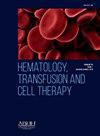EFFICACY OF ROXADUSTAT IN CHRONIC KIDNEY DISEASE PATIENTS NOT ON DIALYSIS WITH ANEMIA: SYSTEMATIC REVIEW AND META-ANALYSIS OF RANDOMIZED CONTROLLED TRIALS
IF 1.6
Q3 HEMATOLOGY
引用次数: 0
Abstract
Objective
Anemia is a common complication in patients with Chronic Kidney Disease (CKD), particularly in those not receiving dialysis. Roxadustat, a Hypoxia-Inducible Factor Prolyl Hydroxylase Inhibitor (HIF-PHI), has been investigated as a therapeutic option for anemia management in this population. This study aimed to evaluate the efficacy of Roxadustat compared to control interventions in Non-Dialysis-Dependent CKD (NDD-CKD) patients.
Methodology
A comprehensive literature search was conducted in Cochrane CENTRAL, Ovid Medline, PubMed, and Web of Science up to December 14, 2024. Randomized Controlled Trials (RCTs) directly comparing Roxadustat with a control group were included. Data were pooled using an inverse variance-weighted random-effects model. The primary efficacy outcome was the change in Hemoglobin (Hb) levels at weeks 24–28 and during follow-up. Subgroup analyses were performed based on the type of control intervention (Erythropoiesis-Stimulating Agents [ESAs] vs. placebo) and prior ESA use.
Results
A total of six RCTs, including 5,330 patients, from 520 unique records from the databases were included. Roxadustat significantly increased Hb levels during follow-up compared to the control group (Mean Difference [MD = 1.21 g/dL], 95% confidence interval [95% CI 0.45 to 1.97], I² = 99%, p = 0.0017). However, at weeks 24–28, the increase in Hb levels was not statistically significant (MD = 0.86 g/dL, 95% CI -0.11 to 1.83, I² = 99.4%, p = 0.0833). Iron-related parameters showed mixed results. Roxadustat was associated with a significant reduction in ferritin levels (MD = -38.54 ng/mL, 95% CI -68.21 to -8.87, I² = 84.1%, p = 0.0109). Conversely, Total Iron-Binding Capacity (TIBC) was significantly increased with Roxadustat treatment (MD = 20.33 μg/dL, 95% CI 1.15 to 39.51, I² = 98.5%, p = 0.0377). No significant difference was observed in serum iron (MD = 3.1 μg/dL, 95% CI -0.39 to 6.6, I² = 93.1%, p = 0.0820) and Transferrin Saturation (TSAT) levels (MD = -1.08%, 95% CI -2.42 to 0.26, I² = 40.1%, p = 0.1151) between the two groups. Subgroup analyses revealed that in placebo-controlled trials, Roxadustat significantly increased Hb levels at both weeks 24–28 and during follow-up. However, in trials comparing Roxadustat with ESAs, the changes in Hb levels were not significant at either time point.
Conclusion
Roxadustat reduced ferritin but increased TIBC without significantly affecting free iron and TSAT levels compared to the control group in patients with NDD-CKD.
罗沙司他对非透析性贫血慢性肾病患者的疗效:随机对照试验的系统评价和荟萃分析
目的贫血是慢性肾脏疾病(CKD)患者的常见并发症,尤其是未接受透析治疗的患者。罗沙司他是一种缺氧诱导因子脯氨酸羟化酶抑制剂(HIF-PHI),已被研究作为贫血管理的治疗选择。本研究旨在评估罗沙司他与对照干预在非透析依赖性CKD (NDD-CKD)患者中的疗效。方法对截至2024年12月14日的Cochrane CENTRAL、Ovid Medline、PubMed和Web of Science进行综合文献检索。纳入直接比较罗沙他与对照组的随机对照试验(RCTs)。数据采用方差加权逆随机效应模型进行汇总。主要疗效指标是24-28周及随访期间血红蛋白(Hb)水平的变化。亚组分析基于对照干预的类型(促红细胞生成素与安慰剂对照)和既往的促红细胞生成素使用。结果共纳入6项随机对照试验,包括5330例患者,来自数据库的520条独特记录。与对照组相比,罗沙司他在随访期间显著提高了Hb水平(Mean Difference [MD = 1.21 g/dL], 95%可信区间[95% CI 0.45 ~ 1.97], I² = 99%,p = 0.0017)。然而,在第24-28周,Hb水平的增加没有统计学意义(MD = 0.86 g/dL, 95% CI -0.11 ~ 1.83, I² = 99.4%,p = 0.0833)。与铁有关的参数显示出不同的结果。罗沙司他与铁蛋白水平显著降低相关(MD = -38.54 ng/mL, 95% CI -68.21 ~ -8.87, I² = 84.1%,p = 0.0109)。相反,罗沙司他治疗组总铁结合容量(TIBC)显著升高(MD = 20.33 μg/dL, 95% CI 1.15 ~ 39.51, I² = 98.5%,p = 0.0377)。无显著差异在血清铁(MD = 3.1μg / dL, 95%可信区间-0.39到6.6,我² = 93.1%,p = 0.0820)和转铁蛋白饱和度(TSAT)水平(MD = -1.08%,95%可信区间-2.42到0.26,我² = 40.1%,p = 0.1151)之间的两组。亚组分析显示,在安慰剂对照试验中,Roxadustat在24-28周和随访期间显著增加Hb水平。然而,在比较罗沙司他和esa的试验中,Hb水平在两个时间点的变化都不显著。结论与对照组相比,罗沙司他降低了NDD-CKD患者的铁蛋白,但增加了TIBC,但未显著影响游离铁和TSAT水平。
本文章由计算机程序翻译,如有差异,请以英文原文为准。
求助全文
约1分钟内获得全文
求助全文
来源期刊

Hematology, Transfusion and Cell Therapy
Multiple-
CiteScore
2.40
自引率
4.80%
发文量
1419
审稿时长
30 weeks
 求助内容:
求助内容: 应助结果提醒方式:
应助结果提醒方式:


